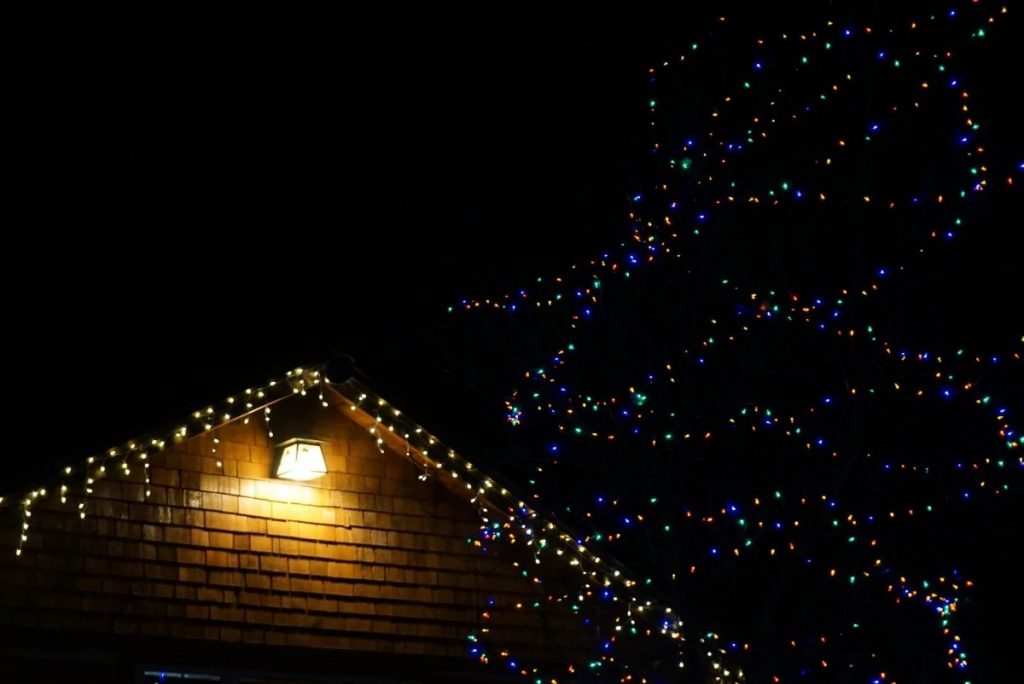Whether you just plan on hanging a string of classic white lights over the eaves or have full-on Griswold style ambitions on your mind of transforming your home into a winter wonderland, lighting up the home for the holidays is a lot of fun. Unfortunately, it can also be risky. Every year thousands of people spend the holiday season in pain thanks to light related accidents such as slipping off ladders, back issues from hauling too much, or even electrocution.
Here’s what you need to know to hang your lights safely and enjoy the festive show all season long!
Take stock before heading outside
There are few things as frustrating and humbling as spending a bunch of time precariously balanced on a ladder in sub-zero temperature, painstakingly threading and securing your lights, only to find out they don’t work when you try to turn them on.
Examine your lights before taking them outside. Plug them in and make sure there are no duds you’ll need to climb back up to and swap later. While you’re at it, make sure they are certified for outside use, and if you’ve used them in previous seasons, that the line is free of any exposed wire, nicks, or gouges. Any kind of damage can present a fire risk. While you might not think a little kink or nick out of a wire is a big deal, why take the chance? It’s far easier to replace a line of lights than your home!
Reaching for the top
Of course, you should always practice ladder safety, but if there was ever a time to be especially vigilant, it’s during the windy winter months. With winds battering you off balance, snow and sleet getting in your eyes, and the cold wearing away at your coordination and encouraging you to take reckless shortcuts, putting up the Christmas lights is likely the most dangerous time you’ll spend on a ladder all year.
Place your ladder on a firm, flat surface. If snow and ice have built up around the area you want to place the ladder, get out the shovel and salt before you start. If you can, have someone on hand to hold the ladder steady while you climb it and to be there in case there is an accident. Be sure to dress appropriately as well – wear non-slip boots, a heavy coat, gloves, a hat, and some kind of face protection. If you’re having trouble manipulating the snaps and hooks with the gloves on, consider taking a set of hand warmers in your pockets and taking frequent breaks to avoid frostbite.
Make it easy on yourself and your home
Don’t mess around with old-school wires and screw-on solutions. There are a number of different kinds of plastic hooks and snaps you can place on your eaves with a minimum of fuss from a ladder. Not only will these plastic hooks not damage your eaves, you also won’t have to get up on the roof and risk slipping off or damaging it during the snowy season.
Go with the current
Of course, the best part of setting up the lights for the year is going through your collection of extension cords. After you hunt them down from wherever you stored them last year and manage to detangle them, you’re going to want to give them the same inspection you gave the light strings. Double check that they are rated for outside use and carefully inspect the entire line for any signs of damage. Frayed casing, budging kinks, plastic warping around the plugs and connector ends, and so on. Any of these flaws can indicate something is wrong with the cord and you’re always better safe than sorry when it comes to fire risks.
Are you going with classic incandescent lights? Then you should never connect more than three strings together. Any more and you’re risking a fire threat. On the other hand, if you’re using more modern LEDs, the risk is less dire. You can hook up to 25 strands of LEDs together and unless you’re planning to have your home double as a landing strip for disoriented aircraft, that should be more than enough.

Lights out
Lastly, consider getting a timer that will automatically turn off the lights after midnight. There is no need to burn electricity and inflate your monthly hydro bill keeping your lights on for the one car that might wander down your block at 2:00 am.
A timer will make sure you aren’t wasting good juice this season. This might sound unnecessary, that you’ll just do it yourself, but this can be easier said than done. If you have an indoor switch, turning them off at night might just be a matter of remembering to do it, but that’s difficult to do when you spend most of the year not having to worry about it. If you have to go outside and unplug an extension cord, there are definitely going to be nights where it is too cold, and you’re too tired or already in your pajamas to want to wander out in the snow. A timer just makes things nice and easy.
Follow these tips, and keep your holidays bright and safe this season!







0 Comments